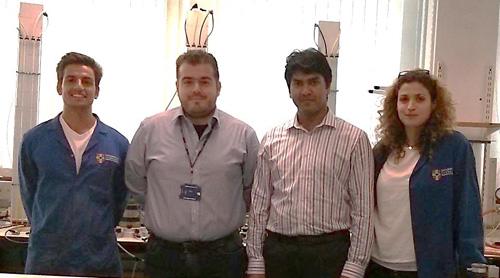
Submitted by Administrator on Thu, 07/11/2013 - 12:38
A project that aims to create construction materials with an inbuilt self-healing system was voted the most likely research to have the biggest global impact, as well as the most likely to have the biggest effect on human lives, at this year's British Science Festival.
"I hope that in the next 2-3 years we will be reporting on field trials of self-healing concrete and that there is sufficient support from the Construction Industry to further develop and embed these new materials in their projects."
—Dr Diane Gardner, Cardiff University
A team from the Materials for Life (M4L) project, funded by the Engineering and Physical Sciences Research Council (EPSRC), presented their findings at a 'You Heard it Here First' session at the festival in Newcastle.
The audience of science enthusiast attendees voted for the M4L project after listening to five-minute presentations from academics working across a wide scientific spectrum, from the effects of gravitational waves to the role of quantum physics in metrology to using high precision lasers in imaging. Dr Diane Gardner, Co-Director BRE Institute in Sustainable Engineering at Cardiff University School of Engineering, explained how the M4L project is exploring ways of producing construction materials that will repair themselves when their integrity is threatened through cracking and other forms of damage.
Dr Gardner said: "To win an award about research that has the potential to have the biggest global impact is truly exciting. It demonstrates that others share our vision for creating resilient infrastructure that can adapt, sense and respond to damage, which has the potential to reduce or eliminate both environmentally and economically costly repair and maintenance activities. My colleagues and I at Cardiff, Cambridge and Bath Universities are working hard to make this vision a reality. I hope that in the next 2-3 years we will be reporting on field trials of self-healing concrete and that there is sufficient support from the Construction Industry to further develop and embed these new materials in their projects."
The Department of Engineering at the University of Cambridge will play a major part in this EPSRC and industry-funded project. Dr Abir Al-Tabbaa (lead), together with Dr Janet Lees and Dr Michelle Oyen from Engineering and Professor Chris Abell from Chemistry form the Cambridge academic team. The work at Cambridge will focus on the experimental development and analytical investigations of a nano/micro-scale self-healing system via microencapsulation applicable to construction materials. The research will consider suitable shell and cargo materials investigating different triggers and the associated healing mechanisms. A range of cargos including chemical solutions, powders and bacterial spores will be tested for release and healing efficiency. This will then be followed by larger scale laboratory testing leading to field trials in collaboration with the project's industrial partners.
The team of Cambridge researchers who have the exciting task of making self-healing construction materials a reality is expanding. Dr Antonis Kanellopoulos will lead the team as the Research Associate on the M4L project. Chrysoula Litina, a third year PhD student has been focussing on the creating of various microcapsules using different techniques and developing the appropriate measurements and assessment techniques. Tanvir Qureshi, a second year PhD student is looking at the use of mineral additives and biological agents as self-healing components and Petros Giannaros has just started as a first year PhD student and will focus on
